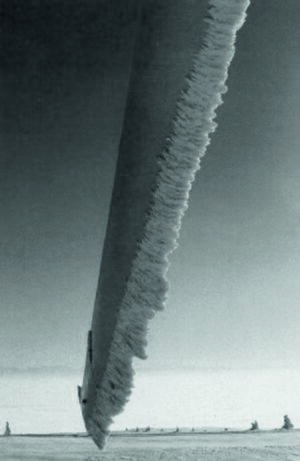Icing on wind turbine blades

Wind turbines can encounter different types of atmospheric icing depending on the conditions.
Different ice types can accrete on the leading edges of the wind turbines, and these ice types are mainly formed from in-cloud icing events; clouds and fog containing supercooled droplets hits the turbine blade, and the icing occurs. Depending on the droplet size in the clouds or fogs rime or glaze is formed on the leading edge and nearby areas of the blades.
Icing on wind turbine blades depends on both the operating (temperature, velocity, MVD Median Volume Diameter and LWC Liquid Water Content) and geometric (size and shape) characteristics. Different operating and thermodynamic conditions on the wind turbine blades will result in the accreted ice being of different densities and shapes. [2] The change in accreted ice shapes affects the air flow behaviour on the blade profile and its aerodynamic performance. [3]
Ice formations on the wind turbines inflict severe problems on operation; reduces lifetime and causes power losses. Ice formed on the blades and other parts of the turbine causes increased load on the turbine structure, which can in the worst case lead to failing on the wind turbine. In some cases the ice formation on the leading edge of the blade can lead to shutdown of the whole turbine. Ice accretion on the leading edge also affects the aerodynamic performance of the wing. Accreted ice changes the aerodynamic balance of the blades, which reduces drag coefficient that increases power losses. Even a small ice accretion on the blade will change the surface roughness of the blade, which can cause power losses due to changed aerodynamic behavior.
Standstill time can be reduced by applying different de- and anti-icing methods. By using de-icing methods the accreted ice can be melted during the standstill. Heating resistance based anti-icing methods can be operated during turbine operation.
One important aspect concerning icing in wind turbines is ice throw risk. Different size ice pieces can plunge far away from the turbine, which causes risk to nearby infrastructure and can inflict serious damage to people and structures in the nearby areas. Ice falling off from turbine also hinders the accessibility of maintaining personnel to wind turbine. Proper risk assessment is required in wind turbine installations.
More on this topic: wind turbine blades aerodynamics.
References
- ↑ N. Dalili, A. Edrisy, R. Carriveau, A review of surface engineering issues critical to wind turbine performance, Renewable and Sustainable Energy Reviews, vol. 13, no. 2, 2009, pp. 428–438.
- ↑ Muhammad S. Virk, Matthew C. Homola, and Per J. Nicklasson, Effect of Rime Ice Accretion on Aerodynamic Characteristics of Wind Turbine Blade Profiles, Wind Engineering, vol. 34, pp. 207 – 218, No. 2, 2010.
- ↑ Jaiwon Shin, Berkowitz Brian, Chen Hsun, and Cebeci Tuncer, Prediction of ice shapes and their effect on airfoil performance, NASA Techical Memorandum 103701, 1991.
- ↑ O. Parent & A. Ilinca, Anti-icing and de-icing techniques for wind turbines: Critical review,” Cold Regions Science and Technology, Vol. 65, No. 1, 2011, pp. 88–96.
- ↑ R. Carriveau, A. Edrisy, P. Cadieux, and R. Mailloux, “Ice Adhesion Issues in Renewable Energy Infrastructure,” vol. 26, 2012 pp. 447–461.
- ↑ A. G. Kraj & E. L. Bibeau, Phases of icing on wind turbine blades characterized by ice accumulation, Renewable Energy, vol. 35, no. 5, 2010, pp. 966–972.
- ↑ I. Baring-Gould, R. Cattin, M. Dustewitz, M. Hulkkonen, A. Krenn, T. Laakso, A. Lacroix, E. Peltola, G. Rönsten, L. Tallhaug, T. Wallenius, Wind Energy Projects in Cold Climates, IEA Wind 13.task, 2012 43 p. Available: https://www.ieawind.org/index_page_postings/June%207%20posts/task%2019% 20cold_climate_%20rp_approved05.12.pdf.
- ↑ B. Martinez, Implementing H & S strategies to mitigate ice throw risk, Optimizing wind farms in cold climates, presentation, Helsinki, Finland, 2014.
- ↑ Properties of icephobic surfaces in different icing conditions. Stenroos Christian. Master of Science Thesis. TAMPERE UNIVERSITY OF TECHNOLOGY. October 2015. Online.
- ↑ Jia Yi Jin. Study of Atmospheric Ice Accretion on Wind Turbine Blades. 2021. Thesis for the degree of Philosophiae Doctor. UiT ̶ The Arctic University of Norway Faculty of Engineering Science and Technology.